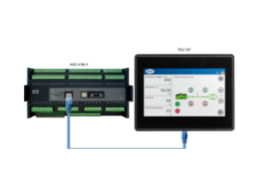The instrument is mounted on DIN-rail (6TE) and features RS-485, USB, Ethernet communication interface, four universal input/output terminals, and additional input for Pt100 temperature sensors. It is a robust solution for harsh and challenging environments of a typical smart grid deployment with measurement category CATIV/300V and wide industrial temperature. Optionally it offers a color LCD. Large 512MB internal storage memory logs all the measured data locally.
BC 235 with proper hall sensors can analyze DC components, the standard 5Hz-2.5kHz, and optionally supra-harmonics in the range between 2 and 9 kHz. It has a sampling mode DC-500, which is also suitable to analyze standard industrial variable frequency drives frequency (VFD, adjustable speed drive controllers).
It can also monitor power quality (with PQ-S or PQ-A module) – inter-harmonics, flicker, voltage events, record transients (with GO module), and the ripple control signals (RCS module). To the standard power quality monitoring application, the BC 235 can add an advanced ability also to detect DC current components in the measured AC network and thus analyze the influence of the DC appliances or power sources on the quality of the AC side of the distribution grid.
Key features
Works well in booth DC and AC application domains,
can be customized to fit all LVDC nominal voltages,
is designed for smart grid environments – wide temperature and CATIV/300V measurement category acc. to IEC 61010,
possible DC power supply with backup option – see PWR 1 and PWR 3 smart grid power supplies,
uses HALL sensor current inputs with DC-9kHz measurement capability,
is an ideal supervising complement to a multi feeder DC monitoring system with EMI 12 HALL modules,
has 512MB internal memory for data logging, automatic meter readings, and profiles, to store power quality datasets,
evaluates PQ indices such as total harmonic distortion (THD), up to 128 harmonics from DC to 2.5 kHz, and supra-harmonics from 2 to 9 kHz,
has a programmable pulse or alarm digital outputs, pulse or solid-state digital inputs, and pt100 temperature input,
offers remote RS 485 and fast Ethernet communication interfaces.










